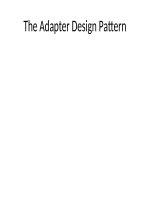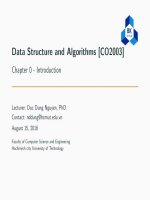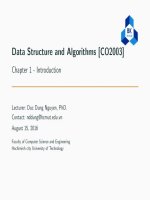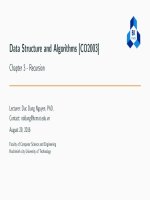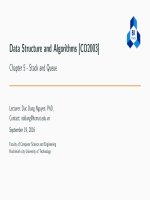C++ programming program design including data structure 7th ch17
Bạn đang xem bản rút gọn của tài liệu. Xem và tải ngay bản đầy đủ của tài liệu tại đây (1.42 MB, 102 trang )
Chapter 17:
Stacks and Queues
Objectives
• In this chapter, you will:
–
–
–
–
–
Learn about stacks
Examine various stack operations
Learn how to implement a stack as an array
Learn how to implement a stack as a linked list
Learn about infix, prefix, and postfix expressions, and how
to use a stack to evaluate postfix expressions
C++ Programming: Program Design Including Data Structures, Seventh Edition
2
Objectives (cont’d.)
–
–
–
–
–
–
Learn how to use a stack to remove recursion
Learn about queues
Examine various queue operations
Learn how to implement a queue as an array
Learn how to implement a queue as a linked list
Discover how to use queues to solve simulation problems
C++ Programming: Program Design Including Data Structures, Seventh Edition
3
Stacks
• Stack: a data structure in which elements are added
and removed from one end only
– Addition/deletion occur only at the top of the stack
– Last in first out (LIFO) data structure
• Operations:
– Push: to add an element onto the stack
– Pop: to remove an element from the stack
C++ Programming: Program Design Including Data Structures, Seventh Edition
4
Stacks (cont’d.)
C++ Programming: Program Design Including Data Structures, Seventh Edition
5
Stacks (cont’d.)
C++ Programming: Program Design Including Data Structures, Seventh Edition
6
Stacks (cont’d.)
C++ Programming: Program Design Including Data Structures, Seventh Edition
7
Stack Operations
• In the abstract class stackADT:
–
–
–
–
–
–
initializeStack
isEmptyStack
isFullStack
push
top
pop
C++ Programming: Program Design Including Data Structures, Seventh Edition
8
Implementation of Stacks
as Arrays
• First element goes in first array position, second in
the second position, etc.
• Top of the stack is index of the last element added to
the stack
• Stack elements are stored in an array, which is a
random access data structure
– Stack element is accessed only through top
• To track the top position, use a variable called
stackTop
C++ Programming: Program Design Including Data Structures, Seventh Edition
9
Implementation of Stacks as Arrays (cont’d.)
• Can dynamically allocate array
– Enables user to specify size of the array
• class stackType implements the functions of
the abstract class stackADT
C++ Programming: Program Design Including Data Structures, Seventh Edition
10
Implementation of Stacks as Arrays (cont’d.)
C++ Programming: Program Design Including Data Structures, Seventh Edition
11
Implementation of Stacks as Arrays (cont’d.)
• C++ arrays begin with the index 0
– Must distinguish between:
• Value of stackTop
• Array position indicated by stackTop
• If stackTop is 0, stack is empty
• If stackTop is nonzero, stack is not empty
– Top element is given by stackTop - 1
C++ Programming: Program Design Including Data Structures, Seventh Edition
12
Implementation of Stacks as Arrays (cont’d.)
C++ Programming: Program Design Including Data Structures, Seventh Edition
13
Initialize Stack
C++ Programming: Program Design Including Data Structures, Seventh Edition
14
Empty Stack/Full Stack
• Stack is empty if stackTop = 0
• Stack is full if stackTop = maxStackSize
C++ Programming: Program Design Including Data Structures, Seventh Edition
15
Push
• Store the newItem in the array component
indicated by stackTop
• Increment stackTop
• Overflow occurs if we try to add a new item to a full
stack
C++ Programming: Program Design Including Data Structures, Seventh Edition
16
Push (cont’d.)
C++ Programming: Program Design Including Data Structures, Seventh Edition
17
Push (cont’d.)
C++ Programming: Program Design Including Data Structures, Seventh Edition
18
Return the Top Element
• top operation:
– Returns the top element of the stack
C++ Programming: Program Design Including Data Structures, Seventh Edition
19
Pop
• To remove an element from the stack, decrement
stackTop by 1
• Underflow condition: trying to remove an item from
an empty stack
C++ Programming: Program Design Including Data Structures, Seventh Edition
20
Pop (cont’d.)
C++ Programming: Program Design Including Data Structures, Seventh Edition
21
Pop (cont’d.)
C++ Programming: Program Design Including Data Structures, Seventh Edition
22
Copy Stack
• copyStack function: copies a stack
C++ Programming: Program Design Including Data Structures, Seventh Edition
23
Constructor and Destructor
• Constructor:
– Sets stack size to parameter value (or default value if not
specified)
– Sets stackTop to 0
– Creates array to store stack elements
• Destructor:
– Deallocates memory occupied by the array
– Sets stackTop to 0
C++ Programming: Program Design Including Data Structures, Seventh Edition
24
Copy Constructor
• Copy constructor:
– Called when a stack object is passed as a (value) parameter
to a function
– Copies values of member variables from actual parameter
to formal parameter
C++ Programming: Program Design Including Data Structures, Seventh Edition
25

